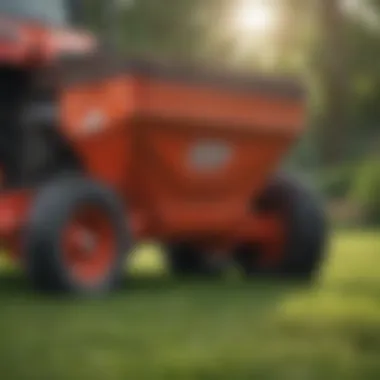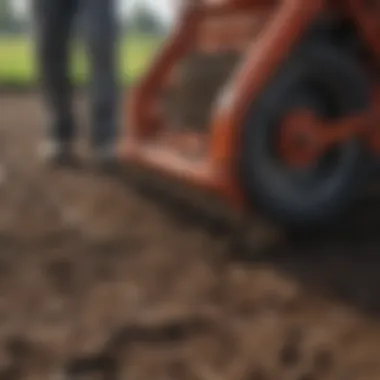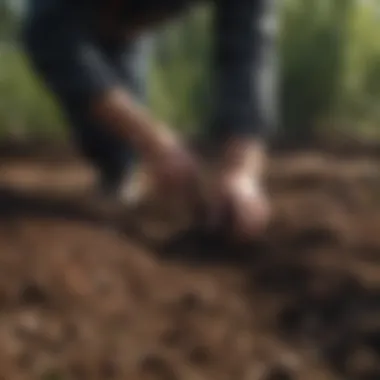Essential Tools for Planting Grass Seed Effectively


Intro
Planting grass seed effectively requires more than just scattering seeds on bare soil. It involves understanding the necessary tools and techniques that can make a difference. This guide aims to equip both novice and seasoned gardeners with the knowledge of essential tools needed for this task.
Topic Overview
Definition and Importance
Planting grass seed is a crucial part of lawn care and landscape management. It involves sowing seeds to establish a healthy and lush lawn. The right tools not only facilitate this process but ensure better results. Using appropriate implements can save time, minimize effort, and enhance seed germination. When you consider the visual appeal and ecological benefits of a well-maintained lawn, investing in proper tools becomes indispensable.
Brief History and Evolution
Historically, planting grass was performed using rudimentary tools made from wood and stone. As society advanced, so did the tools available. The introduction of metal implements marked a significant turning point. In the 20th century, machinery began to play a pivotal role, offering greater efficiency. Today, advanced technology, including seeders and aerators, provides options for any type of gardener, blending tradition with modern efficiency.
Key Techniques and Innovations
Sustainable Farming Practices
Sustainable practices in grass planting focus on minimizing environmental impact. Techniques like no-till planting improve soil health and retention. Tools designed for these practices include biodegradable seed mats and environmentally safe fertilizers, fostering a stronger foundation for grass growth. Integrating these methods can result in greener and healthier lawns while promoting overall biodiversity.
Advanced Agronomic Technologies
Modern innovations offer high-tech options for planting grass. Seeders with GPS tracking and automated watering systems are examples. These tools optimize seed placement and watering schedules, improving seed survival rates. Familiarity with such technologies can greatly enhance gardening efficiency.
Practical Applications
Step-by-Step Guides
- Assess your soil: Before purchasing tools, examine the soil type and condition. Knowing the right amendments to add can influence tool choice.
- Select the right seeds: Choose grass seed based on your climate and intended lawn use. Understand the growth habits of different varieties.
- Prepare the soil: Tools such as cultivators and rakes should be utilized for proper seedbed preparation.
- Plant the seeds: Depending on scale, manual methods can suffice, but for large areas, a seeder is preferable.
- Water and maintain: Employing proper watering tools ensures seeds get the moisture they need for germination.
Case Studies or Real-World Examples
Many successful gardening projects illustrate the benefits of utilizing the right tools. For example, a community garden initiative in Portland, Oregon, adopted sustainable practices alongside advanced seeders. The result was a significant decrease in resource usage and a lush, thriving green space that engaged the local community.
"The key to resilience in lawn care is adaptability and understanding your tools."
By combining traditional knowledge with new technologies, users reported notable success in their grass planting endeavors.
Closure
Understanding the essential tools for planting grass seed lays the foundation for a thriving lawn. By examining historical advancements, embracing sustainable practices, and implementing modern technology, gardeners can enhance their experiences and outcomes. Armed with the right tools and knowledge, both novice gardeners and seasoned experts can enjoy the satisfaction that comes from a healthy green space.
For more information on sustainable gardening practices, visit Britannica and for discussions, check Reddit.
Understanding the Importance of Tools in Grass Seed Planting
When planting grass seed, the tools used can significantly influence the outcome. Grasping the importance of these tools provides clarity on how to achieve a lush, healthy lawn. Choosing the right implement allows for efficient seeding and soil management, leading to successful germination and growth.
The Role of Proper Tools
Proper tools serve as the foundation for effective grass planting. Each tool is designed for specific tasks that prepare the ground, distribute seeds, and promote seed establishment. For instance, seeders ensure even seed distribution, while rakes prepare the soil surface for optimal seed-to-soil contact. The integration of various tools can streamline the process, diminishing the labor involved and fostering a more productive planting environment.
Using quality tools also enhances the gardener’s execution. High-quality equipment often yields better results and decreases the chance of damaging the seeds or soil during planting. Therefore, understanding the specific tasks each tool performs is essential. The careful selection of these tools can also minimize repetitive stress injuries that may occur from using inadequate equipment over extended periods.
Impacts on Seed Germination and Growth


The tools utilized during planting do not solely impact the immediate process; they also affect germination and long-term growth. Tools that aerate the soil, for example, create pathways for water and nutrient absorption, enhancing seed viability. Properly prepared soil lowers the risk of compaction, ensuring seeds have the necessary environment to germinate.
A lack of proper tools can lead to uneven planting, affecting how the seeds establish themselves. This inconsistency can result in patchy growth, which may necessitate further intervention in the future.Therefore, understanding these nuanced impacts is not merely academic; it can dictate the success of the entire planting endeavor.
"Choosing the right tool is not just about efficiency; it's about ensuring that every seed has the best chance to thrive."
In summary, the significance of selecting proper tools for grass seed planting cannot be understated. Proper implements facilitate an efficient planting strategy, improve seed germination, and ultimately contribute to a more sustainable lawn. The resulting impact manifests not only in aesthetics but also in long-term health and viability.
Essential Manual Tools
When it comes to planting grass seed, the tools you select are as crucial as the seeds themselves. Manual tools offer a hands-on approach that is often necessary for achieving optimal results. Each implement serves a specific purpose, providing a range of benefits to facilitate successful grass establishment. The right manual tools enhance soil preparation, seed placement, and overall management of the planting process.
Seeders: Types and Selection
Seeders are fundamental for spreading grass seed evenly across the soil. There are several types available, including hand-held seeders, mechanical push seeders, and broadcast seeders. Each type has its strengths. For small areas, a hand-held seeder can provide precision; however, for larger plots, a mechanical push seeder may cover ground more efficiently. When selecting a seeder, consider factors like the size of your lawn, the type of grass seed, and the desired application rate. It is essential to ensure that the seeder’s settings align with the specific requirements of your chosen seed, promoting effective coverage and reducing waste.
Hand Rakes: Importance in Soil Preparation
Hand rakes play an undervalued role in soil preparation. They help to break up clumps and redistribute soil evenly. This action is critical for ensuring that grass seeds have adequate soil-to-seed contact, which facilitates moisture retention. A good hand rake should have sturdy tines that can penetrate the soil without bending. It is advisable to rake the soil lightly to create a fine seed bed. This preparation is crucial, as a well-aerated seed bed significantly influences germination rates and the overall health of the grass.
Trowels: Precision Planting
Trowels are essential for tasks that require precision, such as planting grass seed in specific areas or patches. This small tool allows for targeted planting, minimizing disturbance to the existing soil structure. When using a trowel, you can create small holes or furrows to house seeds without over-exposing the surrounding area. Proper seed depth is also vital; generally, seeds should be planted no deeper than twice their size. A trowel’s versatility makes it a useful addition to any gardener’s toolkit for selective planting.
Shovels: Breaking Ground Effectively
Shovels are heavy-duty tools that are necessary for breaking ground effectively. Whether you are starting a new lawn or renovating an existing one, a shovel allows for turning soil and mixing organic matter or amendments into the ground. It is important to use the right type of shovel for the job—round-head shovels are excellent for digging, while square-head shovels work better for slicing through sod and turning the dirt. Using a shovel properly can prepare the soil for even seed distribution and create a suitable environment for growth.
Garden Forks: Aerating Soil
Garden forks aid in the aeration of soil, which is fundamental for healthy grass growth. By loosening compacted soil, they improve drainage and allow air to reach the roots. This tool features sturdy tines that penetrate the ground and should be used before planting. Aerating the soil creates a hospitable environment for grass seeds, enhancing nutrient uptake. A well-aerated lawn can withstand drought better and has a stronger resistance to disease, allowing for robust lawn health over time.
"The right tools not only make grass planting easier but also significantly improve the chances of success."
In summary, these essential manual tools greatly contribute to the foundational steps of planting grass seed. Understanding how to use them effectively will lead to healthier lawns and a more rewarding gardening experience.
Mechanical Tools for Grass Seed Planting
Mechanical tools play a crucial role in the efficient planting of grass seed. These tools enhance the process, making it quicker and more effective. They can significantly increase the scale at which one can work, allowing for larger areas to be seeded in a shorter amount of time. Additionally, mechanical tools can help ensure more uniform distribution of the seed, which is essential for achieving consistent growth and a healthy lawn.
There are several types of mechanical tools that cater to different aspects of planting grass seed. Each tool has its specific purpose and benefits, depending on the job at hand. Understanding these tools allows users to choose the right ones, ensuring optimal results during the planting process. Now, let's explore the various mechanical tools in detail.
Broadcast Seeders: Advantages and Utilization
Broadcast seeders are a popular choice for many landscape professionals and homeowners. They function by distributing seeds over a large area uniformly. This is achieved by tossing seeds from a rotating disk, ensuring even coverage. The advantages of using a broadcast seeder include:
- Efficiency: Allows for rapid seeding of lawns or large areas, reducing labor time.
- Uniformity: Helps in distributing seeds evenly, which is essential for germination and growth.
- Versatility: Can be used for various types of seeds, not just grass.
When utilizing a broadcast seeder, it’s essential to calibrate the machine based on the seed type and size to prevent under sowing or over sowing.
Lawn Rollers: Ensuring Seed-to-Soil Contact
Lawn rollers are used after the seeding process to press the seeds into the soil. This contact is vital because it helps promote seed germination by ensuring that the seeds are in direct contact with moist soil. The benefits of using a lawn roller include:
- Improved Germination Rates: Firm soil contact improves moisture retention around seeds, leading to better germination.
- Cooling Soil: Soil temperatures can be moderated by rolling, which can benefit seed growth in warmer months.
Using the roller must be done with care. Over rolling can compact the soil too much, creating a barrier that can hinder growth.


Turf Renovation Equipment: When to Use
Turf renovation equipment is essential for anyone looking to revive a struggling lawn. When grass shows signs of thinning or patchiness, this equipment comes into play. It typically includes slit seeders and overseeders that create little slits in the soil where grass seed can be deposited.
Knowing when to use this equipment is important. Methods of turf renovation are most effective during early spring or early fall when conditions are ideal for growth. By using these tools, homeowners can restore lawns effectively and efficiently without the need for complete re-sodding.
Tillers: Preparing the Soil for Planting
Tillers are mechanical tools used for soil preparation. They break up hard soil, improving aeration and texture. As a result, better seed-to-soil contact is achieved. The primary advantages of using a tiller include:
- Enhanced Soil Structure: Breaks up compacted soil, allowing for better root growth.
- Incorporation of Amendments: Improves the mix of soil, allowing for better nutrient distribution.
Proper usage of tillers requires an understanding of soil conditions and the desired depth of tilling. Too deep tilling can harm existing roots and disrupt soil microorganisms.
Sprayers: Managing Moisture During Germination
Sprayers are an integral part of the planting process, particularly during the germination phase. Managing moisture is key to promoting seed growth. They allow gardeners to efficiently distribute water or fertilizer over the newly seeded area.
Using a sprayer offers several benefits:
- Controlled Watering: Ensures that seeds receive the right amount of moisture without over-saturating.
- Fertilizer Application: Some sprayers can also handle liquid fertilizers, providing nutrients directly where needed.
It is important to select the right type of sprayer for the job, as not all sprayers provide even coverage. A properly calibrated sprayer will help maintain the necessary moisture levels that seeds require for germination.
In summary, utilizing mechanical tools for grass seed planting can radically enhance the efficiency, effectiveness, and overall success of the seeding process. Understanding the specific roles of each tool helps users make informed decisions, ensuring healthy and robust lawn growth.
Additional Tools and Accessories
In the realm of grass seed planting, additional tools and accessories complement the primary implements, enhancing the overall efficiency and effectiveness of the seeding process. While manual and mechanical tools cover the brunt of the work, these extra tools can provide essential support for achieving optimal results. Each of these accessories fulfills a specific purpose that can be crucial in the planting journey.
Soil Test Kits: Assessing Compatibility
Soil test kits play an integral role in preparing for grass seed planting. Understanding soil composition is vital. These kits allow gardeners to analyze pH levels and nutrient content. This information helps in determining the type of grass that will thrive in a given environment.
When utilizing soil test kits, one should consider the following:
- Selecting the Right Kit: Many types of kits exist, such as home testing kits or those requiring laboratory analysis.
- Interpreting Results: Knowing how to read the results is critical. Adjustments to soil pH and nutrient levels can be decided based on the findings.
- Timing: It is best to test the soil months before planting to allow time for amendments to take effect.
Gloves: Protecting Your Hands
Gloves might appear as a simple accessory, but they are essential. Gardening often involves manual labor, which can lead to injury or skin irritation. A good pair of gloves protects against potential cuts, scrapes, and exposure to chemicals.
Considerations when choosing gardening gloves include:
- Material: Different materials, like leather or synthetic options, offer various levels of protection and breathability.
- Fit: Properly fitting gloves allow for flexibility and comfort, which is vital when handling tools and soil.
- Durability: Investing in high-quality gloves can save money in the long run, as they will endure repeated use.
Watering Equipment: Maintaining Moisture Levels
Proper moisture management is crucial for seed germination and growth. Watering equipment, such as hoses, sprinklers, and watering cans, enables effective irrigation throughout the planting phase.
When selecting watering tools, it is important to consider:
- Type of Watering System: Options may include manual methods like handheld cans or automated systems like irrigation sprinklers.
- Water Pressure: The water pressure in your area can impact how effectively seeds are watered without displacing them.
- Timing: Knowing when to water is also essential. Early mornings or late evenings are often the best times.
Measuring Tools: Ensuring Accurate Coverage
Measuring tools assist in achieving proper seed coverage, avoiding over-seeding or under-seeding. Accurate measurements contribute to an evenly distributed lawn, which promotes healthier growth.


Key measuring tools include:
- Measuring Tape: Useful for determining the area to be seeded to calculate the required seed amount.
- Seed Calculator: Some websites and applications can help in estimating the quantity of seeds based on area and type.
- Guides: Reference charts for seed dispersal rates can aid in understanding how much seed to use per square foot.
Fertilizers: Role in Seed Establishment
Fertilizers serve an essential function in promoting healthy seed establishment. They provide necessary nutrients that may not be present in adequate amounts within the soil. Options range from organic to synthetic fertilizers, each with its own advantages.
Important points regarding fertilizers include:
- Choosing the Right Type: Understanding the difference between nitrogen, phosphorus, and potassium is important—the primary nutrients required for grass growth.
- Application Timing: Timing the application to coincide with seeding can optimize nutrient availability for germinating seeds.
- Following Instructions: Over-fertilization can harm seedlings, so adhering to recommended amounts is crucial.
Proper tools and accessories not only simplify the planting process but also significantly improve the overall health and sustainability of your lawn.
Through the inclusion of additional tools and accessories, gardeners can enhance their planting experience and outcomes. Recognizing the role of each accessory reveals the intricate relationship between preparation and successful grass seeding.
Best Practices for Using Planting Tools
Using the right tools for planting grass seed is essential, but proper practices will significantly enhance the effectiveness of these tools. Adhering to best practices not only ensures accuracy in your work but also prolongs the life span of your tools. Understanding how to calibrate machinery, maintain tools, and store them properly can yield a healthier and more sustainable lawn.
Calibration of Machines: Ensuring Accuracy
Calibration is an often-overlooked step in the process of planting grass seed. When using machines such as broadcast seeders, precise calibration ensures that the right amount of seed is distributed evenly across the planting area. An incorrectly calibrated machine can either waste seed or lead to over-seeding, which may cause uneven growth or competition among grass plants.
To achieve accurate calibration, follow these general steps:
- Read the Manual: Always start by reviewing the manufacturer’s guidelines to understand the specific calibration settings.
- Perform Test Runs: Before you start on your entire lawn, run the machine on a small section to evaluate the distribution and coverage.
- Adjust Settings: Based on your test, make necessary adjustments to the settings for seed flow and distribution patterns.
- Double-Check: Repeat the test run after adjustments to confirm that the seeder is now correctly set.
Proper calibration will not only save you time but also ensure an evenly seeded area that promotes uniform growth.
Maintenance and Care of Tools
Regular maintenance of planting tools is critical for their efficiency and longevity. Neglected tools can lead to poor performance, which ultimately affects grass growth. Consider these key maintenance tips:
- Clean Thoroughly: After each use, remove dirt, debris, and grass clippings. This prevents rust and prolongs the life of metal parts.
- Inspect for Damage: Check tools for any signs of wear or damage. Replace or repair them immediately to avoid using ineffective items.
- Sharpen Blades: Tools like trowels and shovels need sharp edges for precise planting. Regularly sharpen them to ensure clean cuts and less strain on your efforts.
By investing time in maintenance, you ensure tools are always ready for the next seeding session.
Storing Tools: Best Practices
Proper storage of your planting tools is essential to maintain their condition and accessibility. Inadequately stored tools can suffer from corrosion or become hard to find when needed. Here are some effective storage practices:
- Dry Storage: Ensure outdoor tools are stored in a dry location to prevent rust. Use sheds or garages, equipped with proper ventilation.
- Organize: Place tools in an organized manner. Hooks, racks, or pegboards help keep everything visible and easily accessible.
- Handle Treatments: Apply protective oils to metal parts before storage to deter rust. Wood handles can benefit from occasional oiling, which prevents drying and splitting.
By following these storage guidelines, you can keep your tools in prime condition for many seasons to come.
"Effective tool management is not just about usage; it's also about preservation and proper care."
By embracing these best practices for using planting tools, whether manual or mechanical, you will reap better results in your grass seeding activities. The insights provided focus on calibration, maintenance, and storage—elements crucial for positive outcomes in your gardening efforts.
Culmination: The Path to Successful Grass Seeding
In the journey of establishing a lush and vibrant lawn, the conclusion is not just an ending, but a significant marker of what has been learned and how these insights can be applied in real-world scenarios. Understanding the essential tools for planting grass seed plays a crucial role in achieving success. More than just inventory items, these tools represent a commitment to proper technique and care for the environment.
Successful grass seeding is influenced by the choices made during the planting process. From selecting the right seeders or installing tillers, every decision contributes to the viability of the lawn. By considering the right tools, gardeners can enhance germination rates, establish strong root systems, and improve the overall health of the turf.
The benefits of wielding the correct tools extend beyond the immediate planting phase. Optimal tool usage promotes long-term maintenance, ensuring that the lawn will flourish under varied conditions. Regular assessments and adjustments to methods based on tool performance can lead to better results. Key considerations include the amount of seed coverage achieved, the condition of the soil, and how well moisture levels are maintained throughout the germination process.
"Using the right tools is not just about convenience; it’s about creating a sustainable ecosystem for your lawn."
Moreover, the commitment to maintaining and storing tools properly cannot be overlooked. Understanding the intricacies of care will extend the lifespan of equipment, ultimately leading to cost savings and efficiency. Effective maintenance practices cultivate a mindset of responsibility towards gardening tools and their impact on the environment.
In summary, the path to successful grass seeding is paved with knowledge and careful choices. By integrating these essential tools and understanding their applications, gardeners can cultivate a thriving ecosystem that supports healthy grass growth. As an aspiring or seasoned gardener, recognizing the importance of these elements enhances not just the physical landscape, but also contributes to a more rewarding gardening experience.



